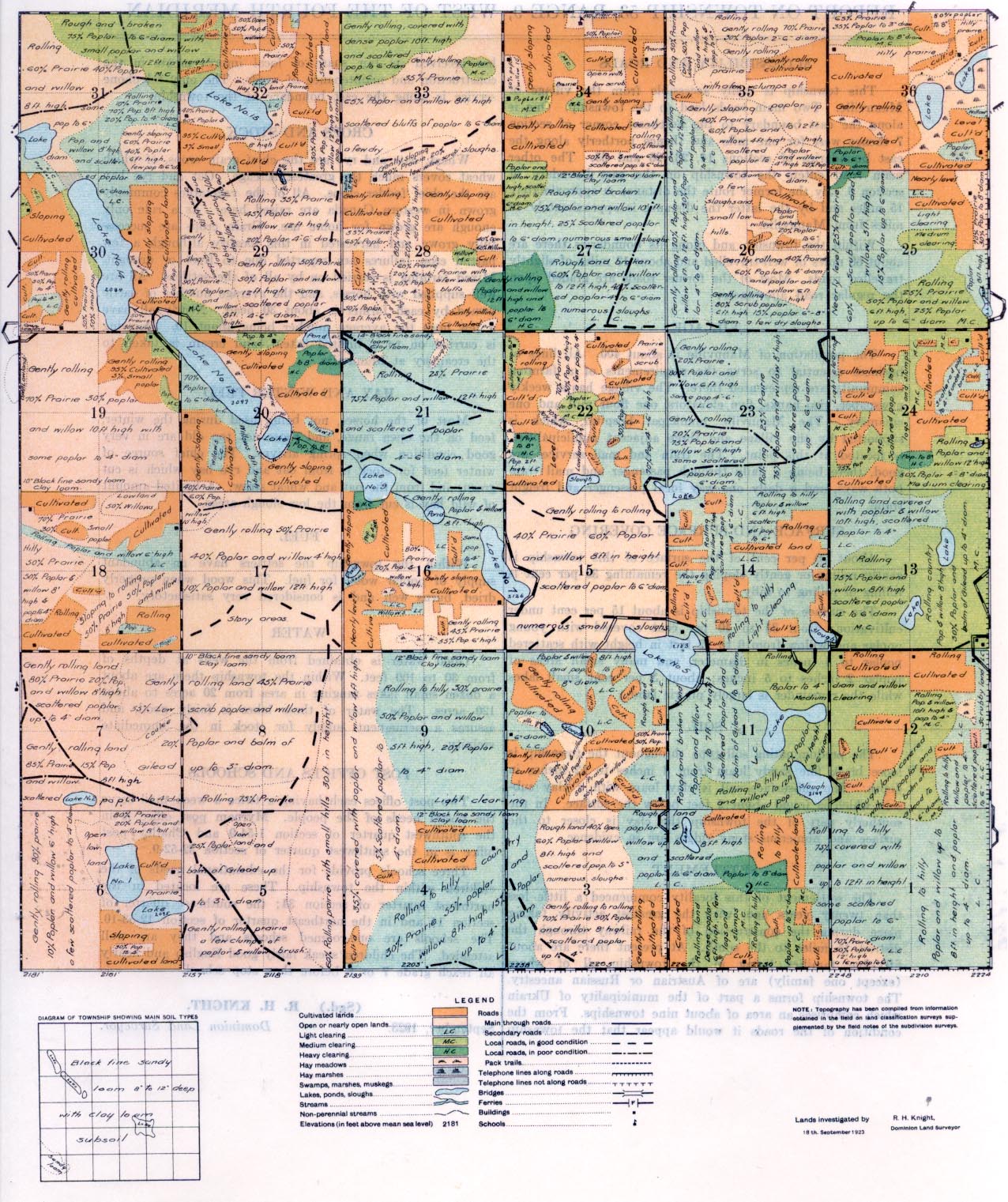
ON TOWNSHIP 53, RANGE 9, WEST OF THE FOURTH MERIDIAN REPORT
ACCESSIBILITY AND ROADS
This township is easily accessible from the village of Mannville. Two main roads lead 4o the township. One is along the east boundary to the northeast corner of section 7 thence west for one mile and thence northerly along the east boundaries of sections 14, 23, 26 and 35. The other main road enters the township on the east boundary of section 6. By the former route the distance is approximately 15 miles and by the latter the distance is approximately 15 miles from Mannville.
Within the township and along its boundaries there are about 60 miles of well-travelled and about 12 miles of slightly travelled roads. Most of the former roads are graded upon the regular road allowances.
VILLAGE
The population of Mannville is about 400. All lines of business essential to serve the requirements of a farming community are represented there. The village has a weekly newspaper, two banks, five elevators, one flour mill and one creamery. The Mannville municipal hospital, which is supported by the village and three adjacent municipalities, is located at this point. The train and mail services are good, there being a daily through passenger and mail train both ways, and a daily one way local passenger and freight train.
SURFACE AND SURFACE COVERING
About 70 per cent of the surface of this township is gently rolling or gently sloping the remaining 30 per cent is rolling or rolling to hilly.
The surface of the township is about 15 per cent under cultivation; from 35 to 40 percent covered with young poplar and willow from 6 to 12 feet in height with scattered poplar to 4 inches in diameter, and many small areas of poplar 2 inches to 5 inches; about 3 per cent small lakes while the remainder is largely prairie land.
SOIL
The predominating soil type throughout the township is loose black fine sandy loam from 8 inches to 12 inches in depth. The subsurface soil is clay loam with a clay sub-soil, which is found about 2 feet below the surface. In the southerly part of the township the clay is closer to the, surface and numerous stony ridges are in evidence.
SETTLEMENT I
The settlement of this locality commenced a little less than twenty years ago, with the greatest activity taking place during the construction of the railway through the district 15 miles to the south. At present there are about fifty-five families living on the township all of whom (except one family) are of Austrian or Russian ancestry. The township forms a part of the municipality of Ukraine, which comprises an area of about nine townships. From the condition of the roads it would appear that the township has received its fair share of local improvements in the construction and maintenance of roads. The only telephone service is along the east boundary of the township.
CROPS AND STOCK
Wheat, oats and rye axe the chief grain crops, of which wheat covers much the greatest acreage. Oat and rye hay are the chief fodder crops. All of the vegetables commonly grown in western Canada are raised here. As a rule only enough are grown for home use. Grain crops are success- fully grown and harvested in this locality although a few partial crop failures are reported due to frost or drought. Mixed farming is carried on by all of the settlers. All are well supplied with horses, and, the average number of cattle owned by each farmer is about 30 head. Nearly all have a few hogs, the average number being about 10. Dairying is carried on to a limited extent, and cream is taken to the creamery at Mannville.
HAY AND WINTER FEED
Most of the horses, not being used during the winter, feed on the open range, and those not too old are in very good. condition 'when spring arrives. The chief source of winter feed for stock is from oat and rye hay which is out green, and from the oat and wheat straw. A limited amount of wild hay is cut from the low slough areas.
FUEL
Within the township the settlers have an abundant supply of poplar wood for fuel. This wood when properly dried, burns well and is considered very satisfactory.
WATER
Good water is obtained from the wells at depths of from, 30 to 100 feet. Within the township there are about a dozen small lakes ranging in area from 20 acres to about 120 acres. The water of these lakes is fairly good, and assures a permanent supply for stock in the immediate vicinity.
POST OFFICES AND SCHOOLS
Two post offices each having a twice a week mail serve the postal needs of the people. Myrnam post office is in the southwest quarter of section 1-54-9 and, Chailey post office is in the southwest quarter of section 32-52-9.
Three schools provide for the educational needs of the children within the township. These are located in the northwest quarter of section 34; the southeast quarter of section 14 and in the northeast quarter of section 12-53-10. The schools are one-roomed schools and they are well attended. The children speak fairly good English and nearly all reach grade 7 or 8 before they stop school.
September 1923
(Sgd.)
R. H. KNIGHT, Dominion Land Surveyor



